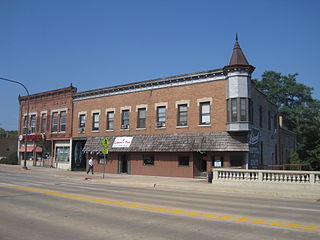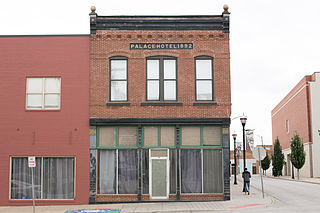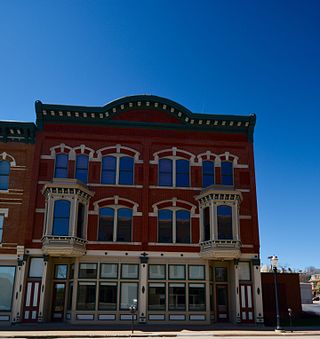
The Kintner House Hotel is a historic bed & breakfast, in the Corydon Historic District in Corydon, Indiana. The present building was built in 1873, and is a 2+1⁄2-story, Italianate style brick building. The original Kintner House, two blocks away, was where John Hunt Morgan learned that Robert E. Lee lost at the Battle of Gettysburg. The Kintner House remained a hotel until 1920 and was used as offices until 1986. It was extensively restored and opened as a bed and breakfast in 1987.

The F. H. Miller House is a historic building located in the central part of Davenport, Iowa, United States. The house served as the official residence for two of Davenport's Catholic bishops and as a bed and breakfast. In 2008, the building then housed the Office of Advancement and Alumni Relations for St. Ambrose University, and was called the St. Ambrose Alumni House. In November of 2023, it was purchased privately from the university and is now The Hilltop Inn of Davenport. The property is currently being restored and preserved as best as possible to many of its original styles and furnishings. The Hilltop Inn of Davenport has recently began business and is operating as a boutique hotel and event rental center for various gatherings. It has been listed on the National Register of Historic Places since 1983.

The Forrest Block is a historic building located in downtown Davenport, Iowa, United States. It was individually listed on the National Register of Historic Places in 1983. In 2020 it was included as a contributing property in the Davenport Downtown Commercial Historic District.

The Schauder Hotel was a historic building located in downtown Davenport, Iowa, United States. It was built in the Italianate style facing the Mississippi River, and it was listed on the National Register of Historic Places in 1983.

The Portland Yamhill Historic District, located in downtown Portland, Oregon, is listed on the National Register of Historic Places.

The Belvidere North State Street Historic District is a historic district on the north side of the Kishwaukee River in Belvidere, Illinois. It is primarily composed of commercial building representative of architectural trends from 1865 to 1962. The district has remained largely intact since the mid-1930s.

The Wright Opera House Block, also known as the Alma Opera House Block, is a commercial block located at 101–113 East Superior Street and 408 North State Street in Alma, Michigan. It was listed on the National Register of Historic Places in 2013.
The Klondike Hotel, also known as the Park Hotel, is a historic building located in Manilla, Iowa, United States. The economic fortunes of Manilla rose and fell with the Chicago, Milwaukee, St. Paul and Pacific Railroad. The two-story, frame, Italianate style hotel was built by H.J. Kopak in 1897. F.M. Offineer was its first owner. The building features a hipped roof, bracketed eaves, and a full-length front porch. It was built a block away from the Milwaukee depot. It served both passengers and crews from trains that had an overnight layover in Manilla. In the early 20th-century Manilla became the junction on the Milwaukee's mainline across Iowa where trains continued on to Omaha or on to the Pacific extension through South Dakota and across the American West. The hotel's name was changed to the Park Hotel in 1903, and an addition was built onto the rear of the hotel in 1905. It went through a succession of owners, and its financial success was dependent on the business brought to it by the railroad. The hotel was listed on the National Register of Historic Places in 1996.

The Wells-Richardson Complex is a historic commercial-industrial area in downtown Burlington, Vermont. Bounded by Main, Pine, College, and St. Paul Streets just west of City Hall Park, the architecture on this one city block represents nearly a century's worth of development. It is dominated by the former plant of the Wells-Richardson Company, a highly successful maker of patent medicines in the late 19th century. The district was listed on the National Register of Historic Places in 1979.

Palace Hotel, also known as the Eldredge Block, Excelsior Steam Laundry, Baltimore Hotel, Gardner Hotel, and Massey Hotel, is a historic hotel building located at Springfield, Greene County, Missouri. It was built about 1892, and is a two-story, Italianate influenced brick commercial building. It has cast iron columns on the first floor storefront, a flat roof, and flat parapet. It originally housed a laundry, then converted to a hotel in 1908. It continued as a hotel until 1946.

The Ziepprecht Block is a historic building located in Dubuque, Iowa, United States. Completed in 1888, it is a fine example of transitional commercial Italianate architecture. The three-story brick structure features a heavy projecting cornice and rounded pediment from the Italianate, with larger paired windows from the Second Empire style, and three-sided bay windows from the Queen Anne style. It is also one of a small number of double storefront blocks that remain in the downtown area. The building is named for Henry Ziepprecht a German-born druggist who settled in Dubuque in 1856 and died in 1887. His estate paid to have this building constructed on the location of an older building that housed his drug store. Now managed by Joseph Wittmer, the drug store and a confectionery were the first businesses to occupy the storefronts. The upper floors housed apartments. The building was listed on the National Register of Historic Places in 2002.

The Lesinger Block, also known as Little Bohemia, is a historic building located in Cedar Rapids, Iowa, United States. This building was constructed at a time of economic expansion in the city. It is a contemporary of several Italianate commercial blocks that were built downtown. Because of subsequent development in that commercial district those buildings have been replaced with newer structures leaving this building as the best extant example of commercial Italianate in Cedar Rapids. It was constructed by Vaclav Lesinger, an immigrant from Kozlov, Bohemia. He was a tailor by trade and he had this structure built in 1883 to house his tailor shop and a dry goods store. Since 1907 the building has housed a tavern that has served as a social center for the local Bohemian community. Architecturally, the two-story brick structure still retains a good deal of its original wood ornamentation, including the sawtooth frieze above the storefronts and the geometric design in the bracketed cornice.

The Forsyth Main Street Historic District is a 4 acres (1.6 ha) historic district in Forsyth, Montana which was listed on the National Register of Historic Places in 1990. It included 24 contributing buildings.

The Hawkeye Insurance Company Building is a historic building located in Des Moines, Iowa, United States. Completed in 1869, the building housed the first successful casualty insurance company in the city, which grew to be the largest center for insurance companies outside of the east coast. Prominent local architect William Foster designed the building, and it may be the oldest surviving example of his work. It is also the oldest commercial building in the downtown area that maintains its original integrity.

The Wolf Hotel, located at 104 E. Santa Fe in Ellinwood in Barton County, Kansas, was built in 1894. It was listed on the National Register of Historic Places in 2002.

The Alma Downtown Historic District in Alma, Kansas, a 5.6 acres (2.3 ha) historic district in Alma, Kansas, was listed on the National Register of Historic Places in 2009. It includes 21 contributing buildings.

The Portage Retail Historic District is located in Portage, Wisconsin.

The Main Street Commercial Historic District is located in Watertown, Wisconsin.

The Portland Skidmore/Old Town Historic District is an historic district in Portland, Oregon's Old Town Chinatown neighborhood, in the United States. The approximately 20-block area, center around Burnside Street and named after the Skidmore Fountain, is known for exhibiting Italianate architecture, though High Victorian Italianate, Renaissance Revival, Richardsonian Romanesque, and Sullivanesque styles are also present. In addition to Skidmore Fountain, structures within the district's boundaries include the Blagen Block, Delschneider Building, Hallock and McMillin Building, New Market Theater, New Market Alley Building, New Market Annex, and Poppleton Building.

The Ouray Historic District, in Ouray, Colorado, is a 114-acre (0.46 km2) historic district which was listed on the National Register of Historic Places in 1983. Many of the commercial buildings are Italianate in style; many residences are Victorian.




















